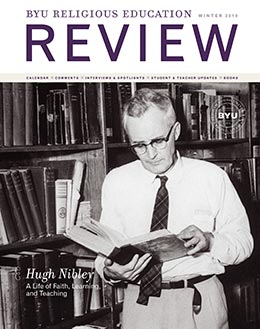Devan Jensen (devan_jensen@byu.edu) was executive editor at the Religious Studies Center when this was published.

What drives a man like Richard Bennett to research and write so prolifically? When asked, Bennett pauses to consider his words. “Spiritually driven curiosity,” he says. “A need to answer questions. We don’t need to be afraid of asking questions. The First Vision occurred because of a question. In fact, I believe that some of our most rewarding experiences come after searching for answers to questions.”
In October, Bennett and his wife, Pat, led his Church History 341 Honors class students on a six-day field trip to answer some of those questions. They presented research findings at the Sacred Grove, the Grandin printing shop, the Peter Whitmer cabin, the Kirtland Temple, the John Johnson home, the Nauvoo sites, and the Carthage Jail. When asked how the trip was, he replied, “Marvelous! It is not a tour; it is a field study trip. What started out as a class on wheels has become a laboratory of faith.”
Students tackled difficult historical questions, then collaborated on the research and presented their findings on-site. Bennett feels this opportunity enriches the students’ BYU education by providing spiritually strengthening, intellectually enlarging, and character-building experiences. “It is a very effective teaching instrument that is unique to BYU,” he says.
“I liked that they taught along the way because it brought the Spirit more into it,” said Greta Martino, a sophomore from Denton, Texas. “I really think this is one of the experiences in my life that has had a great effect on me.”
Philip Volmar, a junior in public relations from Fullerton, California, agreed. “My favorite part of the experience wasn’t just to learn Church history but to live it,” he said. “On a spiritual level, I have a greater understanding of how Jesus Christ influenced the Restoration.”
Bennett’s influence extends beyond the classroom. On April 14, the Arthur H. Clark Company will release his book The Nauvoo Legion: America’s Mormon Militia, coauthored with Donald Q. Cannon and Susan Easton Black. This book tells the definitive story of the original Nauvoo Legion, putting the story of its formation into the context of American and Mormon military history. It features a comprehensive list of those who served and tells how Church leaders learned important lessons from their experience in Missouri.
His new, pathbreaking article on Martin Harris will soon appear in the next issue of the Journal of Mormon History. In “‘Read This I Pray Thee’: Martin Harris and the Three Wise Men of the East,” Bennett shares heretofore untold details of Martin Harris’s 1828 visit to Charles Anthon, Luther Bradish, and Samuel L. Mitchill. Their review of Book of Mormon characters influenced Harris to fund printing of the Book of Mormon.
An enhanced edition of Bennett’s book We’ll Find the Place: The Mormon Exodus, 1846–1848 was published in September 2009 by the University of Oklahoma. This edition features new illustrations of the Mormon Battalion by Thomas L. Kane. It also offers the most comprehensive bibliography ever published on the Mormon exodus. Bennett believes in taking Church history beyond the usual Church audience. He says that people can relate to the Mormons’ persecution and suffering, the epic struggle of the exodus, and the victory that emerged out of tragedy.
Three other books on the early Restoration are in the works. Established as a Prophet: Joseph Smith and the First Principles examines the “incubation period” of the Restoration between 1820 and 1829. The premise he starts with is that people cannot teach what they have not been taught. Of course, the Prophet Joseph was taught the first principles and ordinances of the gospel by divine messengers who carefully tutored him.
A second book, Already to Harvest: Church History for the Modern Missionary, (coauthored with John Livingstone) draws lessons from the journals of the earliest missionaries of the Restoration (most unpublished). In addition to Samuel Smith, Parley P. Pratt, and Orson Pratt, the book features lesser known missionaries such as John L. Butler and Wandle Mace. Lessons include the importance of gaining a testimony, preparing a foundation of knowledge, learning to get along with companions, using the Bible and Book of Mormon, emphasizing the first principles and ordinances of the gospel, and teaching with the Spirit. These lessons are interspersed with passages from Preach My Gospel.
A third book, In the Year of Our Lord 1820, actually provided the inspiration behind many of his other works. This larger volume seeks to enrich our understanding of the events of 1820 by placing them in the intellectual landscape of important world events of the period.
Bennett says, “Whether it is taking classes out to Church history sites, publishing articles and books on a variety of Church history and doctrinal issues and questions, participating in interfaith dialogues, attending academic conferences, or encouraging fellow faculty members in their research and publishing endeavors, I believe that we as faculty have a responsibility to teach well within our classrooms but also beyond the traditional classroom setting. Research informs and inspires good classroom instruction, and vice versa.”
